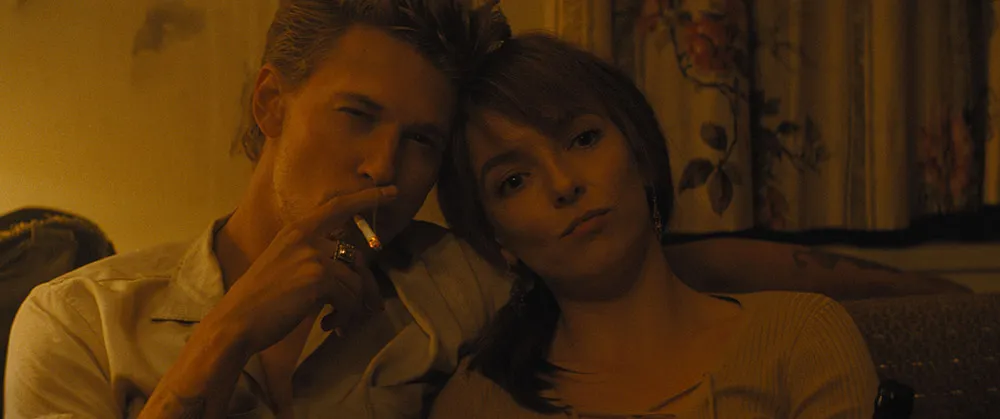London Film Festival 2023: THE BIKERIDERS

All I know is that Oscar Isaac would make a…
The Bikeriders is the latest film from writer and director Jeff Nichols (Take Shelter, Loving). Inspired by Danny Lyons’ 1968 book of the same name, it follows the Vandals motorcycle gang across the 1960s and 70s, centered around Kathy (Jodie Comer), a headstrong outsider to the group, and her husband Benny (Austin Butler), a reckless young Vandals member.
A risk-taking cast
The cast is ostensibly led by Butler’s Benny – it’s him on the poster and the focus of the trailer – but it’s Comer’s Kathy who’s the real leader of this story. Running her a close second is Tom Hardy’s Johnny, the leader of the Vandals. Toss in Michael Shannon as the bitter, heavy-drinking Zipco; Emory Cohen as the proudly bug-eating Cockroach; and Toby Wallace (Pistol, Babyteeth), close to being typecast now as “rebellious tearaway”, as the mistreated and aggressively ambitious “Kid”; and (mentioning just a few) you’ve got a great cast.

Most of Butler’s screentime consists of him smouldering in the knowledge of just how handsome he is. Comer, on the other hand, is doing Big Character Acting as a strong-willed midwesterner, skirting the border of comedy sketch characterisation. Hardy meanwhile, playing Vandals leader Johnny, gets to combine the bravado of Brando from The Wild One (almost literally) and the quiet power of Brando from The Godfather, while plucking out another voice from his interesting accent tombola. Almost everyone is taking a big swing.
Yet almost every inch of it works. And it’s because people are swinging for the fences, not in spite of it. The real people these characters are based on are people we might politely call “characters” if we met them in everyday life. So it’s fitting the cast play them that way: as chaotic and as colourful as the real people that inspired Nichols’ Vandals once were.
Direction over dialogue
Ironically, Comer’s Kathy is perhaps the biggest character, but also the most likeable. First meeting the Vandals, she expresses the same trepidation most people would. But she doesn’t judge them – so we don’t either. It means Nichols doesn’t need to waste time getting us on their side. Nor does he retread that familiar narrative road, often spelt out through clunky dialogue, about how this gang is really, at the end of the day, just a family, you know? A place where outcasts can come together in harmony and solidarity, if you get it?

Instead, he shows that closeness both through story – in Johnny ordering the burning of the bar where Benny is beaten up and badly injured, as though the mere sight of it might bring back bad memories for Benny – and through direction: the quiet contentment on the Vandals’ faces as they ride together, tight as an infantry unit, their engines roaring. Nichols has always been good at letting the image and the actors do the work where a less restrained writer might not be able to resist spelling it out. It’s on show here again.
There are a few overarching storylines, from Johnny’s wish for Benny to take over as head Vandal to The Kid’s desire to get into and take them over. But like the photographs that form the foundation of Lyons’ book, the stories are snapshots placed along the broader story of Kathy and Benny’s relationship.
Focusing on performance and place
“It’s a book of photographs, and it has these interviews with these anecdotes. I placed those throughout,” Nichols told Variety. “I’m proud that I took a thing that didn’t have a full narrative structure and made one.” Nichols has succeeded in creating a narrative, no doubt. But it’s not the story that lingers in my mind, nor the feeling of family. It’s the performances and the place.
As Nichols says, for the script (which will campaign for an ‘original’ rather than ‘adapted’ Oscar screenplay nomination), he’s taken “words and images and somehow add[ed] them together, to give you a feeling of nostalgia — to give you a feeling of a time and place.” He’s succeeded more at this than at creating a compelling story.
Nichols and his long-time cinematographer, Adam Stone, capture this time and place not just in the sideburns sliding further down the face as the 60s slide into the 70s, but in the creak of leather jackets, the squeak of the bike under the rider’s weight when he takes his seat, and in almost as much mud as Nichols’ appropriately-named 2012 film, Mud. A contemporary soundtrack, led by The Shangri-La’s, doesn’t hurt either.
Pulling off the gas a little on story might stop this one from lingering in the mind too long. But The Bikeriders film evokes an interesting time and place in US history, in which Nichols‘ ensemble cast take big swings – and get big enough hits.
The Bikeriders is in US cinemas from December 1, 2023!
Does content like this matter to you?
Become a Member and support film journalism. Unlock access to all of Film Inquiry`s great articles. Join a community of like-minded readers who are passionate about cinema - get access to our private members Network, give back to independent filmmakers, and more.













